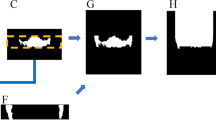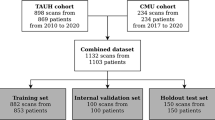Abstract
The objective of this study is to use a deep-learning model based on CNN architecture to detect the second mesiobuccal (MB2) canals, which are seen as a variation in maxillary molars root canals. In the current study, 922 axial sections from 153 patients’ cone beam computed tomography (CBCT) images were used. The segmentation method was employed to identify the MB2 canals in maxillary molars that had not previously had endodontic treatment. Labeled images were divided into training (80%), validation (10%) and testing (10%) groups. The artificial intelligence (AI) model was trained using the You Only Look Once v5 (YOLOv5x) architecture with 500 epochs and a learning rate of 0.01. Confusion matrix and receiver-operating characteristic (ROC) analysis were used in the statistical evaluation of the results. The sensitivity of the MB2 canal segmentation model was 0.92, the precision was 0.83, and the F1 score value was 0.87. The area under the curve (AUC) in the ROC graph of the model was 0.84. The mAP value at 0.5 inter-over union (IoU) was found as 0.88. The deep-learning algorithm used showed a high success in the detection of the MB2 canal. The success of the endodontic treatment can be increased and clinicians’ time can be preserved using the newly created artificial intelligence-based models to identify variations in root canal anatomy before the treatment.







Similar content being viewed by others
Data availability
The analyzed data sets generated during the study are available from the corresponding author on reasonable request.
References
Davenport T, Kalakota R. The potential for artificial intelligence in healthcare. Future Health J. 2019;6:94.
Ching T, Himmelstein DS, Beaulieu-Jones BK, et al. Opportunities and obstacles for deep learning in biology and medicine. J R Soc Interface. 2018;15:20170387.
Hung KF, Ai QYH, Wong LM, et al. Current applications of deep learning and radiomics on CT and CBCT for maxillofacial diseases. Diagnostics. 2022;13:110.
Redmon J, Divvala S, Girshick R et al. You only look once: unified, real-time object detection. In Proceedings of the IEEE conference on computer vision and pattern recognition. 2016; 779–788
Bayraktar Y, Ayan E. Diagnosis of interproximal caries lesions with deep convolutional neural network in digital bitewing radiographs. Clin Oral Investig. 2022;26:623–32.
Nie Y, Sommella P, O’Nils M, et al. Automatic detection of melanoma with yolo deep convolutional neural networks. 2019 E-Health and Bioengineering Conference (EHB)2019: IEEE.
George J, Skaria S, Varun V. Using YOLO based deep learning network for real time detection and localization of lung nodules from low dose CT scans. Medical Imaging 2018: Computer-Aided Diagnosis2018: SPIE.
Widiasri M, Arifin AZ, Suciati N, et al. Alveolar bone detection from dental cone beam computed tomography using YOLOv3-tiny. 2021 International Conference on Artificial Intelligence and Mechatronics Systems (AIMS)2021: IEEE.
Du M, Wu X, Ye Y, F, et al. A combined approach for accurate and accelerated teeth detection on cone beam CT ımages. Diagnostics. 2022;12:1679.
Zheng Q-h, Wang Y, Zhou X-d, et al. A cone-beam computed tomography study of maxillary first permanent molar root and canal morphology in a Chinese population. J Endod. 2010;36:1480–4.
Smadi L, Khraisat A. Detection of a second mesiobuccal canal in the mesiobuccal roots of maxillary first molar teeth. Oral Surg Oral Med Oral Path Oral Radiol Endod. 2007;103:77–81.
Zhang R, Yang H, Yu X, et al. Use of CBCT to identify the morphology of maxillary permanent molar teeth in a Chinese subpopulation. Int Endod J. 2011;44:162–9.
Weine F, Hayami S, Hata G, et al. Canal configuration of the mesiobuccal root of the maxillary first molar of a Japanese sub-population. Int Endod J. 1999;32:79–87.
Martins JN, Alkhawas M-BA, Altaki Z, et al. Worldwide analyses of maxillary first molar second mesiobuccal prevalence: a multicenter cone-beam computed tomographic study. J Endod. 2018;44:1641–9.
Sempira H, Hartwell G. Frequency of second mesiobuccal canals in maxillary molars as determined by use of an operating microscope: a clinical study. J Endod. 2000;26:673–4.
Barrington C, Balandrano F. Diaphanization techniques in the study of root canal anatomy. In: The root canal anatomy in permanent dentition. Cham: Springer; 2019. p. 57–88.
Schwarze T, Baethge C, Stecher T, et al. Identification of second canals in the mesiobuccal root of maxillary first and second molars using magnifying loupes or an operating microscope. Aust Endod J. 2002;28:57–60.
Verma P, Love R. A micro CT study of the mesiobuccal root canal morphology of the maxillary first molar tooth. Int Endod J. 2011;44:210–7.
Blattner TC, George N, Lee CC, et al. Efficacy of cone-beam computed tomography as a modality to accurately identify the presence of second mesiobuccal canals in maxillary first and second molars: a pilot study. J Endod. 2010;36:867–70.
Cotton TP, Geisler TM, Holden DT, et al. Endodontic applications of cone-beam volumetric tomography. J Endod. 2007;33:1121–32.
Nepal U, Eslamiat H. Comparing YOLOv3, YOLOv4 and YOLOv5 for autonomous landing spot detection in faulty UAVs. Sensors. 2022;22:464.
Wang K, Liew JH, Zou Y et al. Panet: Few-shot image semantic segmentation with prototype alignment. Proceedings of the IEEE/CVF International Conference on Computer Vision. 2019.
Martins JN, Marques D, Silva EJNL, et al. Second mesiobuccal root canal in maxillary molars—a systematic review and meta-analysis of prevalence studies using cone beam computed tomography. Arch Oral Biol. 2020;113:104589.
Betancourt P, Navarro P, Muñoz G, et al. Prevalence and location of the secondary mesiobuccal canal in 1,100 maxillary molars using cone beam computed tomography. BMC Med Imaging. 2016;16:1–8.
Albitar L, Mahdian M. The long journey to set up artificial intelligence (AI) data for automatic detection and localization of missed mesial-buccal (MB2) canals in endodontically-treated maxillary molars with cone beam computed tomography. Oral Surg Oral Med Oral Path Oral Radiol. 2022;134:80.
Normando PHC, Dos Santos JCM, Akisue E, et al. Location of the second mesiobuccal canal of maxillary molars in a Brazilian subpopulation: analyzing using cone-beam computed tomography. J Contemp Dent Pract. 2023;23:979–83.
Betancourt P, Navarro P, Cantín M, Fuentes R. Cone-beam computed tomography study of prevalence and location of MB2 canal in the mesiobuccal root of the maxillary second molar. Int J Clin Exp Med. 2015;8:9128.
Kewalramani R, Murthy CS, Gupta R. The second mesiobuccal canal in three-rooted maxillary first molar of Karnataka Indian sub-populations: a cone-beam computed tomography study. J Oral Biol Craniofac Res. 2019;9:347–51.
Bauman R, Scarfe W, Clark S, et al. Ex vivo detection of mesiobuccal canals in maxillary molars using CBCT at four different isotropic voxel dimensions. Int Endod J. 2011;44:752–8.
Setzer FC, Shi KJ, Zhang Z, et al. Artificial intelligence for the computer-aided detection of periapical lesions in cone-beam computed tomographic images. J Endod. 2020;46:987–93.
Orhan K, Bayrakdar I, Ezhov M, et al. Evaluation of artificial intelligence for detecting periapical pathosis on cone-beam computed tomography scans. Int Endod J. 2020;53:680–9.
Zheng Z, Yan H, Setzer FC, et al. Anatomically constrained deep learning for automating dental CBCT segmentation and lesion detection. IEEE Trans Autom Sci Eng. 2020;18:603–14.
Saghiri MA, Asgar K, Boukani K, et al. A new approach for locating the minor apical foramen using an artificial neural network. Int Endod J. 2012;45:257–65.
Fukuda M, Inamoto K, Shibata N, et al. Evaluation of an artificial intelligence system for detecting vertical root fracture on panoramic radiography. Oral Radiol. 2020;36:337–43.
Johari M, Esmaeili F, Andalib A, et al. Detection of vertical root fractures in intact and endodontically treated premolar teeth by designing a probabilistic neural network: an ex vivo study. Dentomaxillofac Radiol. 2017;46:20160107.
Jeon S-J, Yun J-P, Yeom H-G, et al. Deep-learning for predicting C-shaped canals in mandibular second molars on panoramic radiographs. Dentomaxillofac Radiol. 2021;50:20200513.
Sherwood AA, Sherwood AI, Setzer FC, et al. A deep learning approach to segment and classify C-shaped canal morphologies in mandibular second molars using cone-beam computed tomography. J Endod. 2021;47:1907–16.
Hiraiwa T, Ariji Y, Fukuda M, et al. A deep-learning artificial intelligence system for assessment of root morphology of the mandibular first molar on panoramic radiography. Dentomaxillofac Radiol. 2019;48:20180218.
Funding
This work has been supported by Eskisehir Osmangazi University Scientific Research Projects Coordination Unit under grant number 202045E06.
Author information
Authors and Affiliations
Contributions
All the authors have read and approved the manuscript. Conceptualization: DSB, BIS. Data curation: ODC, BO. Formal analysis: CO Investigation: DSB, ODC Methodology: AESA, YDH. Project administration: OK, JR. Resources: BIS. Supervision: AESA, OK. Validation: JR. Visualization: DSB. Writing—original draft: DSB, ODC, BIS. Writing—review and editing: AESA, OK, PR.
Corresponding author
Ethics declarations
Conflict of interest
The authors declare that he has no conflict of interest.
Ethical approval
This research was approved by Inonu University Scientific Research and publication ethics committee numbered: 2022/3031.
Informed consent
For this type of study, formal consent is not required.
Additional information
Publisher's Note
Springer Nature remains neutral with regard to jurisdictional claims in published maps and institutional affiliations.
Rights and permissions
Springer Nature or its licensor (e.g. a society or other partner) holds exclusive rights to this article under a publishing agreement with the author(s) or other rightsholder(s); author self-archiving of the accepted manuscript version of this article is solely governed by the terms of such publishing agreement and applicable law.
About this article
Cite this article
Duman, Ş.B., Çelik Özen, D., Bayrakdar, I.Ş. et al. Second mesiobuccal canal segmentation with YOLOv5 architecture using cone beam computed tomography images. Odontology 112, 552–561 (2024). https://doi.org/10.1007/s10266-023-00864-3
Received:
Accepted:
Published:
Issue Date:
DOI: https://doi.org/10.1007/s10266-023-00864-3




